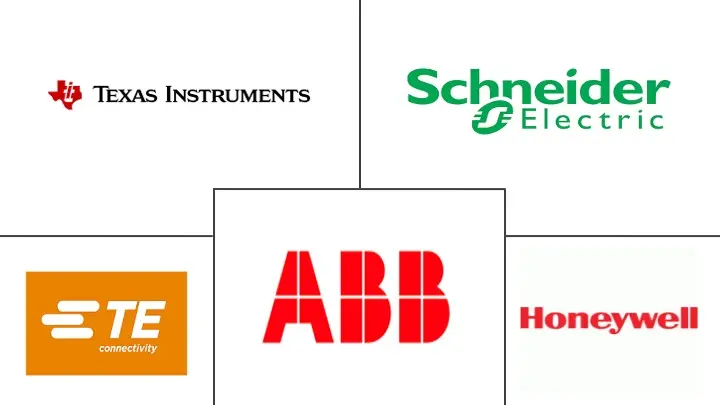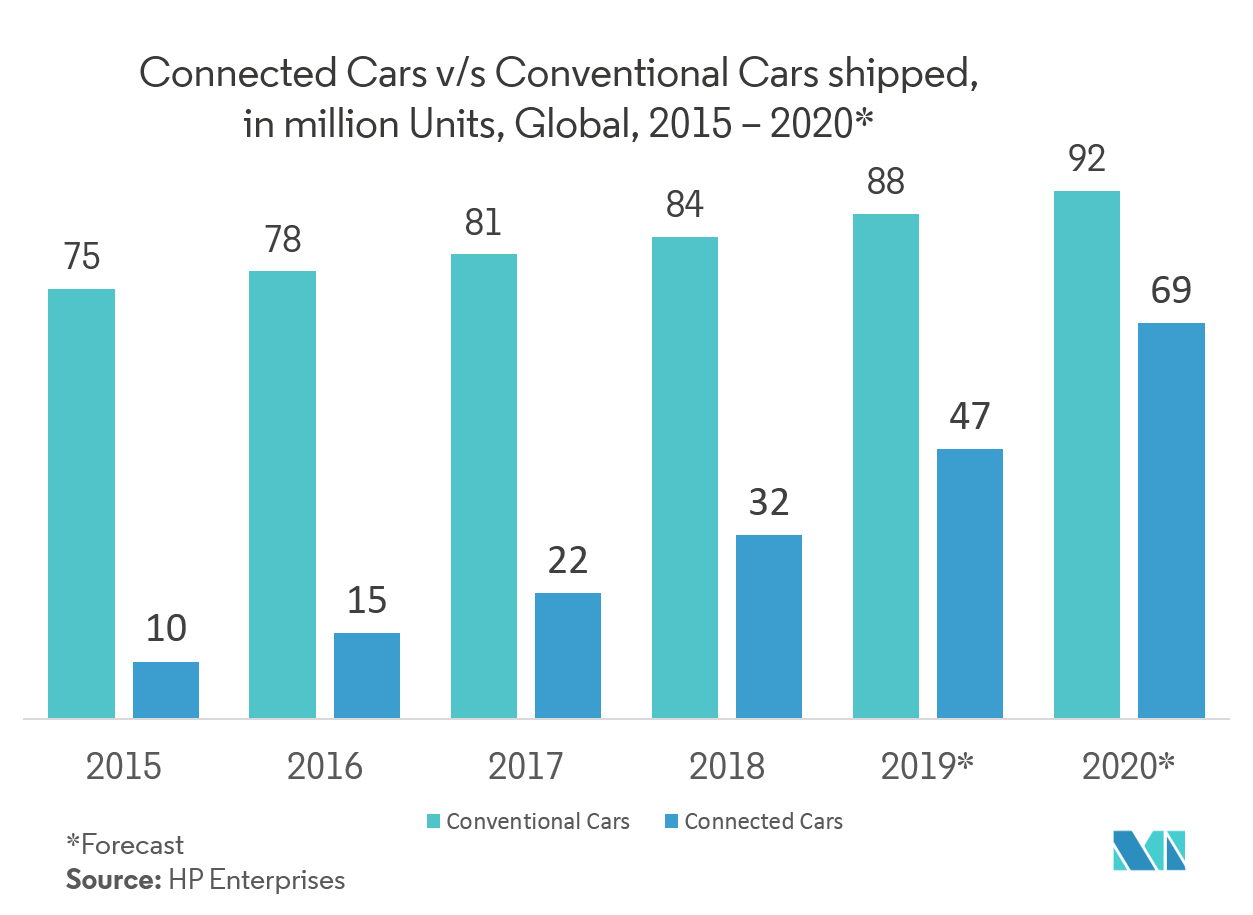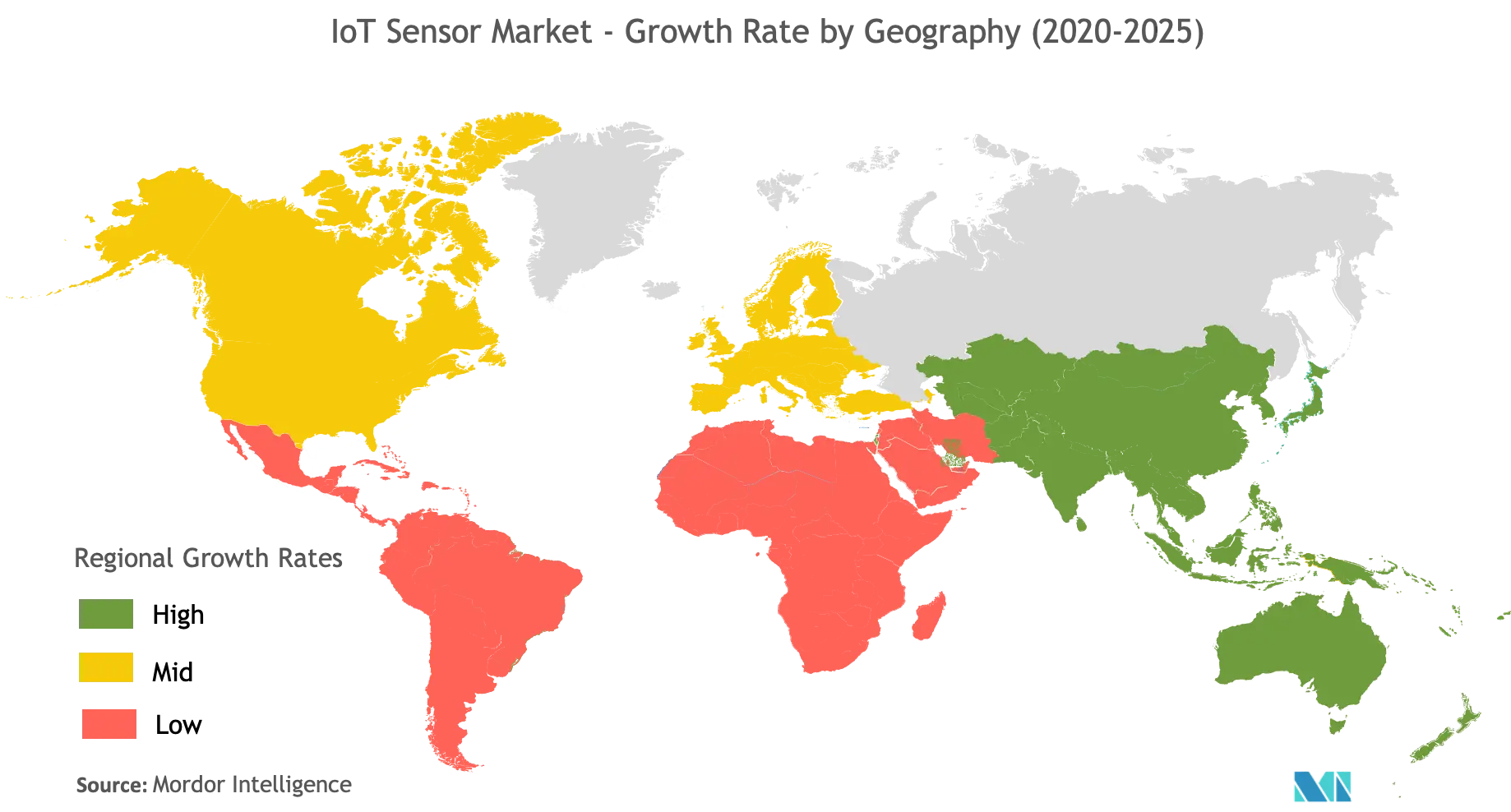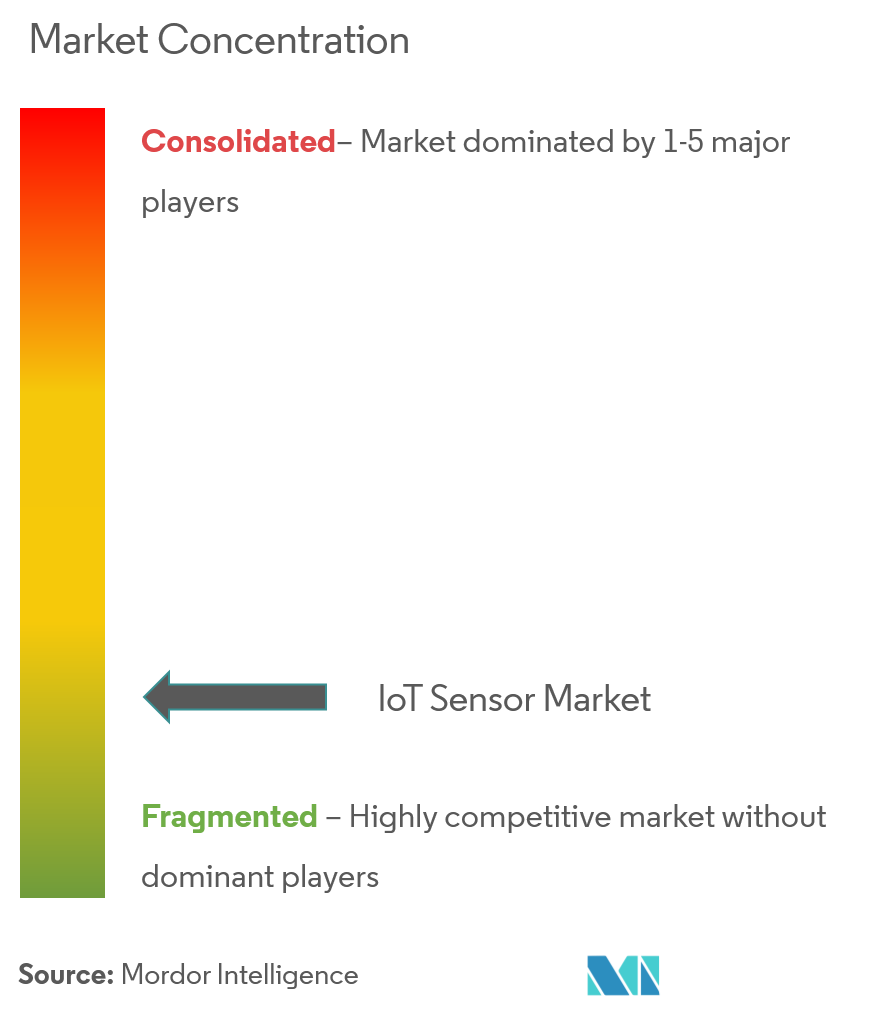IoT Sensor Market Size

| Study Period | 2019 - 2029 |
| Market Size (2024) | USD 34.48 Billion |
| Market Size (2029) | USD 94.82 Billion |
| CAGR (2024 - 2029) | 22.43 % |
| Fastest Growing Market | Asia Pacific |
| Largest Market | North America |
Major Players
*Disclaimer: Major Players sorted in no particular order |
IoT Sensor Market Analysis
The IoT Sensor Market size is estimated at USD 34.48 billion in 2024, and is expected to reach USD 94.82 billion by 2029, growing at a CAGR of 22.43% during the forecast period (2024-2029).
The new emerging applications and business models, coupled with the falling device costs, have been significantly driving the adoption of IoT. Consequently, many connected devices - connected cars, machines, meters, wearables, and consumer electronics. According to the Ericsson study, of the 28 billion total devices connected by 2021, close to 16 billion will be IoT devices. This robust growth is expected to be driven by the increased focus on deploying a connected ecosystem and the standardization of 3GPP cellular IoT technologies.
- Industry 4.0 initiatives across regions like Europe, China, etc., are the major drivers of the IoT deployments, and therefore, the IoT sensors. According to Accenture, 60% of the manufacturing companies are already engaged in IoT projects, and more than 30% are at an early deployment stage. Moreover, the decreasing cost of IoT sensors is one of the prominent factors that would fuel the technology's adoption over the forecast period.
- Besides, smart city initiatives are also instrumental in driving the demand for IoT sensors. Singapore has already implemented a sensor-based Elderly Monitoring System that helps office working family members to receive alerts when the health condition of their home living elderly parents or dependents deteriorates or exhibits abnormal behaviors.
- Further, the advancements in field devices, sensors, and robots are expected to expand the market's scope. IoT technologies are overcoming the labor shortage in the manufacturing sector. For more and more organizations, using Industry 4.0 technologies, like robotization, is part of day-to-day operations.
- For instance, the new-gen IoT sensors, developed on smaller chips/wafers and evolved fabrication units, offer better flexibility, connectivity, and efficiency. It is deemed necessary for upcoming connected factory infrastructure to be visioned, with less power consumption, and are expected to prompt industry to adopt solutions that help them upgrade their infrastructure suited for creating an IIoT environment and complement the demand.
- On the other hand, owing to the recent outbreak of COVID-19, the global supply chain and demand for multiple products have been disrupted. The IoT sensor adoption is expected to be influenced by the end of 2020. Moreover, due to the production shutdown in countries like China, multiple industries have observed a shortage of various products during February and March. However, with the prolonged period of "social distancing," becoming a norm is expected to drive the reliance on automated solutions in various industries. Smart retail, for instance, could see a tremendous boost.
IoT Sensor Market Trends
This section covers the major market trends shaping the IoT Sensor Market according to our research experts:
Automotive and Transportation Industry to Drive the Market Growth
- The automotive sector across the globe is steadily transitioning toward an autonomous era, owing to the recent business collaborations and joint ventures among automotive giants, cybersecurity providers, chip makers, and system integrators.
- This indicates the inevitable advent of highly (Level 4) and fully (Level 5) autonomous vehicles, at the earliest, by 2020. Vehicle connectivity is expected to become necessary for proper communication among vehicles for 'decision-making' proper assimilation and comprehension of visual, geographical, audio, and other data.
- As smart cities emerge, Car2Car connectivity and advanced fleet management are expected to emerge, thus, providing scope for IoT sensors. This has fuelled rapid innovation and the adoption of intelligent sensor technology, driving the demand for IoT sensors.
- Companies such as Mercedes-Benz, Volkswagen, Volvo, Toyota, and Google Inc. are increasingly investing in developing smart cars with rich features that deliver safer, convenient, and comfortable driving experiences. According to a NASDAQ, driverless cars are likely to dominate the market by 2030. Moreover, DHL SmarTrucking aims to build a fleet of 10,000 IoT- enabled trucks by 2028. This is expected to boost the adoption of IoT sensors over the forecast period.
- IoT is also bringing a massive revolution in the automotive, transportation, and logistics industries. Access to preventative maintenance, connected mobility, and real-time data access are significant factors driving IoT adoption in the studied segment. The global IoT transportation and logistics spending almost increased by an exponential rate in the recent times.
- The IoT has enabled many transportation organizations to map the most efficient routes, maximize fuel usage, logistics companies track-and-trace their shipments, and parking start-ups to monitor their available spots in real-time. IoT devices are deployed in traffic congestion control systems in telematics systems within motor vehicles, reservation and booking systems used by transport operators, security and surveillance systems, and remote vehicle monitoring systems.

North America to Account for a Significant Market Share
- North America is one of the largest markets due to several established vendors in the region and the earliest adoption of IoT technology in various industries. Most of the companies in this region are increasingly adopting IoT to keep track of their offering's performance, thus, avoiding costly breakdowns or inefficient routine maintenance shutdowns.
- The usage of IoT in the region is also significantly driving the studied market. For instance, according to a study by Stanford University and Avast, North American homes have the highest density of IoT devices in any region in the world. Notably, 66% of homes in the region have at least one IoT device. Additionally, 25% of North American homes boast more than two devices.
- Further, devices like IoT-enabled medical wearable temperature sensors that transmit data remotely to a central monitoring system are already implemented. Medical staff is alerted based on trends and thresholds, identifying the patient and room, and can respond accordingly.
- Additionally, end-users in Canada have also been investing in the market. For instance, the Canadian energy sector has been procuring internet-connected sensors toward monitoring a range of activities across generating plants, distribution networks, and smart home meters. However, compared to the United States, Canadian companies have been slower to adopt advanced technologies, as per the 2020 Advanced Manufacturing survey of SMEs in North America.
- Further, the demand for IoT sensors in the region is anticipated to grow with the increasing demand for ADAS systems. According to Deutsche Bank, the US ADAS unit production volume will reach 18.45 million by 2021.

IoT Sensor Industry Overview
The IoT sensor market is fragmented, with several sensor manufacturers striving to maintain a competitive edge. This factor is, thereby, intensifying the competition in the market. Players in the market adopt strategic activities such as partnerships, product development, mergers, and acquisitions to capture the market share.
- July 2020: Texas Instruments Incorporated launched the industry's first zero-drift Hall-effect current sensors, TMCS1100 and TMCS110. The new sensors can enable the lowest drift and highest accuracy over time temperature, according to the company. In contrast, they provide reliable 3-kVrms isolation, especially for AC or DC high-voltage systems such as industrial motor drives, solar inverters, energy storage equipment, and power supplies.
- June 2020: TE Connectivity launched the LVDT position sensor. These sensors provide standard and custom solutions based on the hydraulic application requirements of ICT off-highway equipment and industrial machine tools.
IoT Sensor Market Leaders
-
Texas Instruments Inc.
-
ABB Ltd
-
Schneider Electric SE
-
TE Connectivity
-
Honeywell International Inc.
*Disclaimer: Major Players sorted in no particular order

IoT Sensor Market News
- September 2021: Through its subsidiary Beyond Eyes, the Dutch construction company Heijman has deployed some 20,000 LORAWAN smart buildings IoT sensors for its customers. The aim is to enhance the management of buildings by leveraging real-time insights regarding energy and water usage, light intensity, humidity levels, carbon emissions levels, and noise levels while providing occupants with smart home functionalities. Beyond Eyes partnered with IoT connectivity solution firm Actility and IoT senor company Clickey to implement its smart building concept across the Netherlands.
- August 2021: Bouchaine Vineyards, based in Napa Valley, California, shared this week that it has integrated Cisco Systems' sensor technology throughout its 100 acres of vineyards. The Cisco Industrial Asset Vision sensors are installed in multiple areas throughout the vineyard to gather data points, including humidity, water availability, temperature, and light. Extensive vineyards are broken up into "blocks" separated based on topographic features or soil type. The sensors track data block-by-block and upload it to a real-time dashboard.
- September 2020: Amazon launched several new devices and provided more information about its low-power wide-area network called Sidewalk. Amid the crush of news was the announcement of a mailbox sensor made by Amazon's Ring security business. The sensor uses Ring's proprietary 900 Mhz radio to connect to Ring's Wi-Fi bridge device that then alerts the user's phone or Alexa that the sensor has been triggered. The device is simple, and if the mailbox is close enough to the bridge, it will do exactly what it is supposed to do: let people know if someone has opened their mailbox.
IoT Sensor Market Report - Table of Contents
1. INTRODUCTION
- 1.1 Study Assumptions and Market Definition
- 1.2 Scope of the Study
2. RESEARCH METHODOLOGY
3. EXECUTIVE SUMMARY
4. MARKET INSIGHT
- 4.1 Market Overview
- 4.2 Industry Value Chain Analysis
-
4.3 Industry Attractiveness - Porter's Five Force Analysis
- 4.3.1 Bargaining Power of Suppliers
- 4.3.2 Bargaining Power of Consumers
- 4.3.3 Threat of New Entrants
- 4.3.4 Intensity of Competitive Rivalry
- 4.3.5 Threat of Substitute Products
- 4.4 Assessment of COVID-19 Impact on IoT Sensor Market
-
4.5 Market Drivers
- 4.5.1 Rising use of IoT sensors due to reduced cost and size
- 4.5.2 Increasing applications of Industry 4.0 and connected devices
-
4.6 Market Restraints
- 4.6.1 Rising concerns related to data security
5. MARKET SEGMENTATION
-
5.1 By Type
- 5.1.1 Pressure
- 5.1.2 Temperature
- 5.1.3 Chemical
- 5.1.4 Motion/Proximity
- 5.1.5 Other Types
-
5.2 By End User
- 5.2.1 Healthcare
- 5.2.2 Automotive and Transportation
- 5.2.3 Manufacturing / Industrial
- 5.2.4 Other End Users
-
5.3 Geography
- 5.3.1 North America
- 5.3.1.1 United States
- 5.3.1.2 Canada
- 5.3.2 Europe
- 5.3.2.1 United Kingdom
- 5.3.2.2 France
- 5.3.2.3 Germany
- 5.3.2.4 Rest of Europe
- 5.3.3 Asia-Pacific
- 5.3.3.1 China
- 5.3.3.2 Japan
- 5.3.3.3 South Korea
- 5.3.3.4 India
- 5.3.3.5 Rest of the Asia-Pacific
- 5.3.4 Rest of the World
- 5.3.4.1 Latin America
- 5.3.4.2 Middle-East & Africa
6. COMPETITIVE LANDSCAPE
-
6.1 Company Profiles
- 6.1.1 ABB Ltd
- 6.1.2 Schneider Electric SE
- 6.1.3 TE Connectivity
- 6.1.4 Robert Bosch GmbH
- 6.1.5 OMRON Corporation
- 6.1.6 Sensata Technologies
- 6.1.7 Honeywell International Inc.
- 6.1.8 TDK Corporation
- 6.1.9 STMicroelectronics NV
- 6.1.10 Texas Instruments Inc.
- *List Not Exhaustive
7. INVESTMENT ANALYSIS
8. FUTURE OF THE MARKET
** Subject To AvailablityIoT Sensor Industry Segmentation
Internet of things is a network of objects/devices primarily surrounded by sensors, network connectivity, and software to exchange and collect data. Their applications are found in multiple industries, such as healthcare, automotive, transportation, and manufacturing. IoT systems connect specialized devices designed for specific purposes with a limited degree of programmability and customizability. Moreover, IoT systems also store and process data in a distributed manner. The market study primarily comprises estimates derived for sensor types, such as pressure, temperature, chemical, motion/proximity, and similar types. Additionally, the geographical coverage provides the market number for the regions. The country-level data comprises qualitative trends to provide deep insights into the market trends in the region.
| By Type | Pressure | |
| Temperature | ||
| Chemical | ||
| Motion/Proximity | ||
| Other Types | ||
| By End User | Healthcare | |
| Automotive and Transportation | ||
| Manufacturing / Industrial | ||
| Other End Users | ||
| Geography | North America | United States |
| Canada | ||
| Geography | Europe | United Kingdom |
| France | ||
| Germany | ||
| Rest of Europe | ||
| Geography | Asia-Pacific | China |
| Japan | ||
| South Korea | ||
| India | ||
| Rest of the Asia-Pacific | ||
| Geography | Rest of the World | Latin America |
| Middle-East & Africa |
IoT Sensor Market Research FAQs
How big is the IoT Sensor Market?
The IoT Sensor Market size is expected to reach USD 34.48 billion in 2024 and grow at a CAGR of 22.43% to reach USD 94.82 billion by 2029.
What is the current IoT Sensor Market size?
In 2024, the IoT Sensor Market size is expected to reach USD 34.48 billion.
Who are the key players in IoT Sensor Market?
Texas Instruments Inc., ABB Ltd, Schneider Electric SE, TE Connectivity and Honeywell International Inc. are the major companies operating in the IoT Sensor Market.
Which is the fastest growing region in IoT Sensor Market?
Asia Pacific is estimated to grow at the highest CAGR over the forecast period (2024-2029).
Which region has the biggest share in IoT Sensor Market?
In 2024, the North America accounts for the largest market share in IoT Sensor Market.
What years does this IoT Sensor Market cover, and what was the market size in 2023?
In 2023, the IoT Sensor Market size was estimated at USD 28.16 billion. The report covers the IoT Sensor Market historical market size for years: 2019, 2020, 2021, 2022 and 2023. The report also forecasts the IoT Sensor Market size for years: 2024, 2025, 2026, 2027, 2028 and 2029.
IoT Sensor Industry Report
Statistics for the 2024 IoT Sensor market share, size and revenue growth rate, created by Mordor Intelligence™ Industry Reports. IoT Sensor analysis includes a market forecast outlook to 2029 and historical overview. Get a sample of this industry analysis as a free report PDF download.



